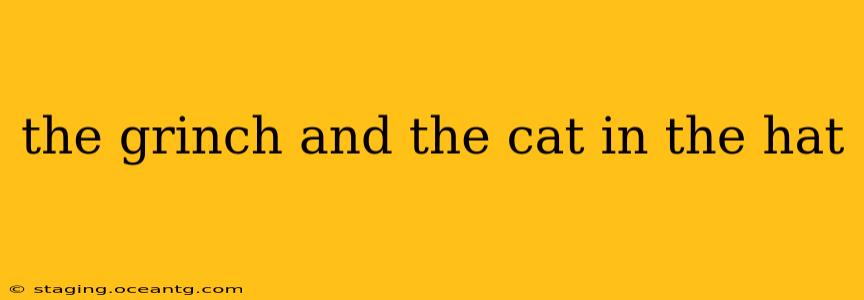Dr. Seuss's whimsical world is populated by memorable characters, both good and bad. Among the most iconic antagonists are the Grinch and the Cat in the Hat, each embodying different aspects of mischief and mayhem. While both disrupt the peace and tranquility of their respective narratives, their motivations, methods, and ultimately, their redemptive arcs, differ significantly. This comparison explores the nuances of these two literary villains and their enduring appeal.
What are the similarities between the Grinch and the Cat in the Hat?
Both the Grinch and the Cat in the Hat are undeniably disruptive forces. The Grinch, driven by his bitterness and solitude, attempts to steal Christmas, while the Cat in the Hat creates chaos and mayhem in the home of the children he is looking after. They both initially present a challenge to the established order, testing the boundaries of acceptable behavior and pushing the limits of their environments. Furthermore, both characters possess a distinct, memorable visual style that contributes heavily to their iconic status. Their unique designs, from the Grinch's furry green exterior to the Cat's tall, red-and-white hat, immediately establish them as distinct personalities within the Seussical landscape.
How are the Grinch and the Cat in the Hat different?
Despite their shared disruption, the Grinch and the Cat in the Hat differ significantly in their motivations and actions. The Grinch's actions stem from deep-seated unhappiness and resentment toward the Whos' joyful celebration. His plan is calculated, albeit ultimately unsuccessful, aiming to silence the merriment he finds so unbearable. The Cat, on the other hand, operates with a more playful, almost chaotic energy. While his actions cause a significant mess, his intent doesn't seem malicious but rather a desire for fun and adventure, even if at the expense of order and tidiness.
What are the Grinch's motivations?
The Grinch's motivations are rooted in his loneliness and discontent. He despises the Whos' joyous Christmas celebrations, viewing their happiness as a direct affront to his own misery. His attempt to steal Christmas is a desperate attempt to silence the sounds of cheer that intensify his feelings of isolation. His grumpy demeanor and cynical outlook on life fuel his desire to disrupt their festive cheer, ultimately revealing a deep-seated insecurity and a yearning for connection.
What are the Cat in the Hat's motivations?
The Cat in the Hat's motivations are far less clear-cut and arguably more ambiguous. He doesn't seem driven by malice or a desire to harm. Instead, his actions suggest a desire to provide excitement and entertainment for the children, even if his methods are unconventional and ultimately lead to significant disarray. He represents a kind of playful rebellion against rules and boredom, providing an escape from the mundane routine of a rainy day.
Does the Grinch change?
Yes, the Grinch undergoes a significant transformation. Witnessing the Whos' unwavering joy despite the theft of their Christmas inspires a profound shift in his perspective. The sheer resilience of their spirit breaks through his cynicism, leading to his eventual redemption and embracing of the Christmas spirit. This redemption is a pivotal moment in the story, highlighting the potential for even the grumpiest of hearts to find compassion and joy.
Does the Cat in the Hat change?
The Cat in the Hat's character arc is less about personal transformation and more about learning responsibility. While he doesn't undergo a radical shift in personality, the chaos he creates necessitates a cleanup, teaching the children (and the audience) the importance of tidiness and responsible behavior. His departure leaves the children to face the consequences of their actions, a lesson in accountability that is arguably more subtle yet equally impactful.
Conclusion: Two Sides of Mischief
Both the Grinch and the Cat in the Hat offer valuable lessons in different aspects of human behavior. The Grinch highlights the potential for redemption and the transformative power of empathy, while the Cat in the Hat provides a cautionary tale about the importance of responsible behavior and accepting the consequences of one's actions. Their lasting appeal lies in their ability to entertain while subtly exploring complex themes of loneliness, joy, and responsibility. They remain timeless icons of children's literature, each leaving an indelible mark on our cultural consciousness.
